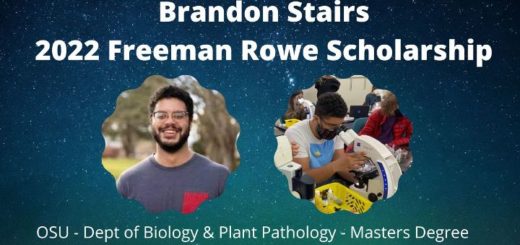Edward Barge 2018 Scholarship Recipient
Grant Proposal Submission by Edward Barge
Community and population ecology of foliar endophytes associated with Populus trichocarpa (black cottonwood) in the Pacific Northwest
Edward G. Barge
Oregon State University, Major: Botany and Plant Pathology
Professional Goals and Interests: My long-term goal is to teach mycology and/or work in a mycology lab in an academic or industrial setting.
Project Background:
The plant microbiome plays an important role in determining plant health and productivity. Within the leaf environment, foliar fungal endophytes are perhaps the most diverse members of the leaf microbial community (Rodriguez t al. 2009). Foliar fungal endophytes inhabit the interior of plant leaves and occur in all land plants where they can contribute to a variety of plant functions, such as growth (Mucciearelli et al. 2003), defense (Arnold et al. 2003), and stress tolerance (Rodriguez & Redman 2008). The vast majority of previous research on foliar fungal endophytes has focused on associates of grasses in agricultural settings, and only recently has there been an increasing focus on foliar fungal endophytes associated with woody plants.
It is often assumed that species within common, widespread genera of foliar fungal endophytes such as Alternaria, Epicoccum, and Cladosporium are ubiquitous and lack geographic structure. Yet recent research of foliar fungal communities using culture-independent high-throughput sequencing methods have revealed that foliar fungal endophyte communities are highly variable at both large and small spatial scales, even within a single host plant species (e.g. Zimmerman & Vitousek 2012, Christian et al. 2016). If foliar fungal endophytes are geographically structured and are a determinant of plant health, connecting endophyte community and population structure to ecological function represents an important step in basic and applied science.
Project Objectives:
My Ph.D. thesis builds on previous work which identified a taxonomically diverse foliar mycobiome in Populus trichocarpa (black cottonwood) with many commonly occurring endophytes capable of impacting the severity of Melampsora leaf rust, a major disease of Populus species worldwide (Busby et al. 2016).
In particular, I ask:
- How does foliar endophyte community composition vary over space (among sites, and between geographic regions) and time (between study years)? Are foliar endophyte communities stable from one study year to the next?
- How are foliar fungal endophyte populations structured? Are there links between endophyte population structure and function?
And, now for Gillian’s Grant Proposal … Read More






